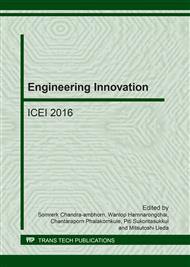p.379
p.384
p.390
p.396
p.402
p.411
p.416
p.422
p.428
The Effect of Eggshells Ash on the Compressive Strength of Concrete
Abstract:
This paper presents the main results of the research carried out to analyse the mechanical properties of concrete incorporating with eggshells waste. The use of eggshells ash in concrete formulations was investigated as an alternative to landfill disposal. The objective of this study is to find the suitability of eggshells ash as cement replacement in concrete. The cement has been replaced by waste eggshells ash accordingly in the range of1% and 2.5%. The eggshell ash passing the 90μm sieve was used in the investigation. By using 1% and 2.5% amount of the waste eggshells ash, water cement ratio were designed which is 0.47, 0.55 and 0.70 and compared in terms of slump and strength with the conventional concrete. The concrete specimens were tested in the series of compression test to determine the strength of concrete for 3, 7 and 28 days. As a result, the additional of eggshells ash to the concrete mix increase the strength of the concrete. In short, the higher percentage of eggshells ash in the mix means a higher compressive strength for the concrete. Hence, it is suggested that eggshells ash can be used as partially cement replacement in concrete.
Info:
Periodical:
Pages:
402-407
Citation:
Online since:
January 2017
Price:
Сopyright:
© 2017 Trans Tech Publications Ltd. All Rights Reserved
Share:
Citation:


